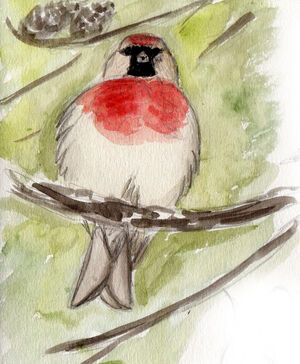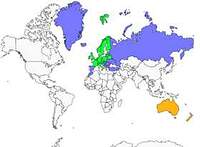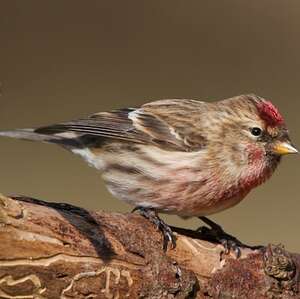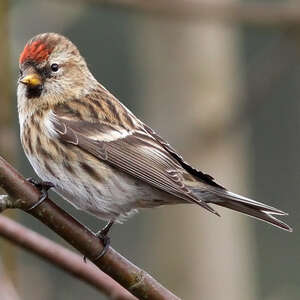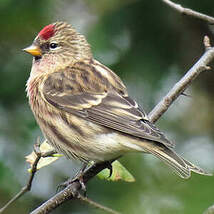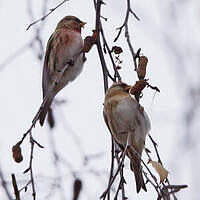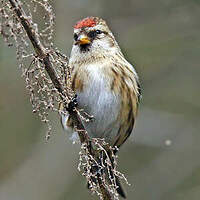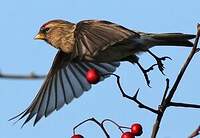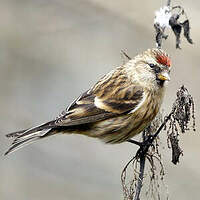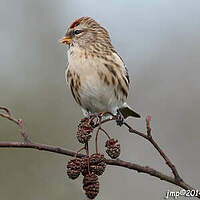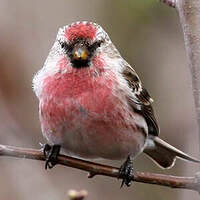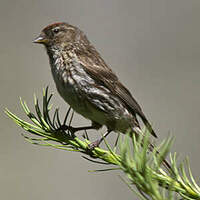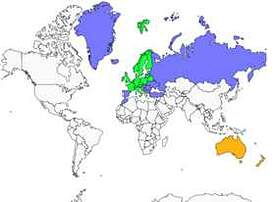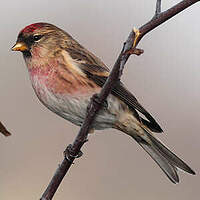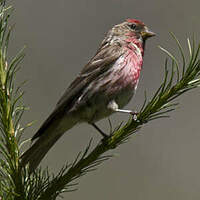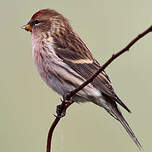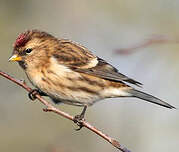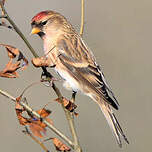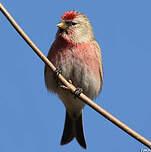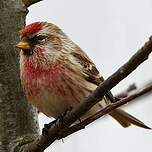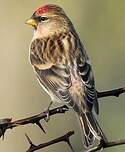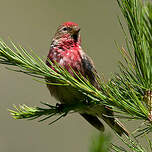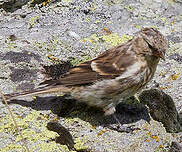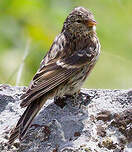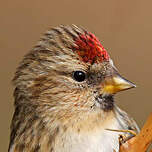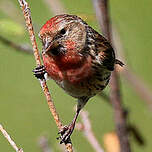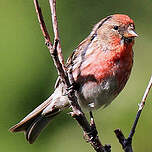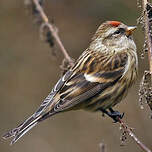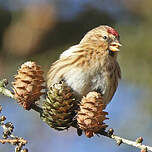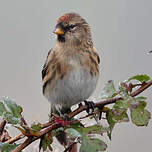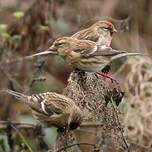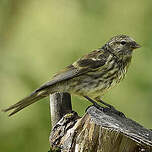Lesser Redpoll
Acanthis cabaret - Sizerin cabaret
Identification
It is extremely difficult to distinguish between the different taxa of Lesser Redpolls based on feathers alone. The location of the sighting is an important initial parameter. Aside from the fairly typical phenotypes, there are many others that are difficult to associate with a specific taxon. In France, only the Lesser Redpoll is a native breeder and winter visitor. The Scarlet Redpoll is a rare and erratic winter visitor. An adult Redpoll can be recognized by the reddish-vermilion forehead and the black bib. The male has an additional pink or red colour on its chest that the female does not have, or is very faint.
The Lesser Redpoll is a bit smaller than the Scarlet Redpoll, from where it gets its english name Lesser Redpoll. The adult, breeding male is darker on its back, without the frosted impression that the Scarlet often has. The mantle does not have the whitish suspenders that are present on the Scarlet, and the two central stripes are simply paler than the others which are tawny. The rump is paler than that of the Scarlet, which makes it less visible in flight. It is coloured pink and is striped. The throat, front of the cheeks, and chest are pink or red, but can be the same reddish-vermilion as the crown in worn feathers. The flanks are more or less striped with brown. The yellowish-straw bill is small and well conical. The feet are rosy to brownish.
The female adult in breeding plumage has a bib that is slightly larger than that of the male, but, most importantly, its chest is rarely coloured like the male's. At most one can see a faint pink hue. The flanks are striped in brown on a ruddy background.
The juvenile is difficult to identify except for the cry, unless it is accompanied by adults. Its head does not have the black and red colouring. The crown is striped in brown-black. The upper parts are tawny and striped with dark brown and white.The wingspan is rufous khaki. The undersides are rufous and heavily streaked with dark brown on the chest and flanks. The beak is brownish.
Subspecific information monotypic species
Foreign names
- Sizerin cabaret,
- Pardillo Alpino,
- pintarroxo-pequeno,
- Alpenbirkenzeisig,
- barna zsezse,
- Kleine Barmsijs,
- Organetto minore,
- brunsiska,
- Brunsisik,
- stehlík hnedkavý,
- čečetka tmavá,
- Lille Gråsisken,
- passerell alpí,
- czeczotka brązowa,
- mazais ķeģis,
- Малая чечётка,
- イメベニヒワ,
- 小白腰朱顶雀,
- 小朱頂雀,
Voice song and cries
The call, emitted in flight, is very typical of the Lesser Redpoll, less so of the considered species.
The call of the Lesser Redpoll is a sharp, sonorous tchi, most often emitted by two or three tchi tchi tchitchi tchi tchitchitchi....
The song is not very elaborate. It is a chattering including sequences of notes such as tututu tututu, djidjidji..., slililili slilili slililili, srii srii srii, all quite fluid, with rolls and trills.
Habitat
Two types of habitat must be distinguished. In the north, in Great Britain, in the south of Scandinavia, in the Benelux, in the north of France, in the north and centre of Germany and in Poland, the birds occupy woodland such as alder-ash, birch, riparian woodland, young conifer plantations, coastal dune woodland and locally parks and gardens.
In the south, it is a mountain dweller, nesting in the Upper Jura and Alps above 1,400 m as well as in the Carpathians as far north as Romania. It nests in sub-alpine forests with spruce, larch, Scots pine, birch, rowan and frequents the adjacent meadows.
Behaviour character trait
Flight
Dietfeeding habits
The Lesser Redpoll is primarily a granivore. It feeds on small seeds of herbaceous plants and trees all year round.
According to a study, the seeds consumed weigh less than 5 mg. Its fondness for birch seeds is well known, which can make up as much as 90% of its winter diet. In times of shortage, it can resort to alder seed. In the spring, numerous seeds of herbaceous plants (asteraceae, brassicaceae, polygonaceae, etc.) are part of its diet. The young are partially fed with various small invertebrates.Reproduction nesting
The breeding season extends from late March to April in the north and from May to July at higher altitudes.
It seems that pair formation occurs during winter gatherings and that partners arrive together on their territory. The male sings in a circular flight while the female chooses the nesting site. She builds it in a shrub or tree more than 5m above the ground on a branch. The male supplies construction material, twigs, stalks, grass, roots, strips of bark, moss, lichen,...roughly assembled. The cup is lined with hair and feathers. The female lays 4 to 6 light blue eggs, slightly speckled with brown and purple lines and spots at the large end. She incubates them for 10 to 12 days. The young stay in the nest for 9 to 14 days, followed by a similar period under the dependence of adults until they are emancipated at about four weeks. During that time, the female can start to consider conditions for a second clutch, which is typical of this species at least in the plain.Geographic range
To the north, the Lesser Redpoll is found in Great Britain, southern Scandinavia, Benelux, northern France, northern and central Germany, and Poland. To the south at higher altitudes, it is found in the High Jura and the Alps above 1400m, as well as in the Carpathians up to northern Romania. The birds are either sedentary or partial migrants depending on the environmental conditions. In winter, they can be found throughout the temperate western Europe.
Threats - protection
Sources of information
- IOC World Bird List (v14.1), Gill, F and D Donsker (Eds). 2024-04-18.
- Finches and Sparrows, Peter Clement
- Les passereaux d'Europe, tome 2, P. Géroudet, M. Cuisin
- Avibase, Lepage Denis
- Birds of the World, The Cornell Lab of Ornithology
- xeno-canto, Sharing bird sounds from around the world,
Other sources of interest
 Specification sheet created on
27/07/2023 by Jean François
Specification sheet created on
27/07/2023 by Jean FrançoisTranslation by AI Oiseaux.net
© 1996-2024 Oiseaux.net
- Accipitriformes
- Aegotheliformes
- Anseriformes
- Apodiformes
- Apterygiformes
- Bucerotiformes
- Caprimulgiformes
- Cariamiformes
- Casuariiformes
- Charadriiformes
- Ciconiiformes
- Coliiformes
- Columbiformes
- Coraciiformes
- Cuculiformes
- Eurypygiformes
- Falconiformes
- Galliformes
- Gaviiformes
- Gruiformes
- Leptosomiformes
- Mesitornithiformes
- Musophagiformes
- Nyctibiiformes
- Opisthocomiformes
- Otidiformes
- Passeriformes
- Pelecaniformes
- Phaethontiformes
- Phoenicopteriformes
- Piciformes
- Podargiformes
- Podicipediformes
- Procellariiformes
- Psittaciformes
- Pterocliformes
- Rheiformes
- Sphenisciformes
- Steatornithiformes
- Strigiformes
- Struthioniformes
- Suliformes
- Tinamiformes
- Trogoniformes

